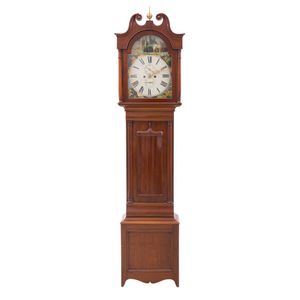Regency Mahogany Longcase Clock with Arched Hood
You must be a subscriber, and be logged in to view price and dealer details.
Subscribe Now to view actual auction price for this item
When you subscribe, you have the option of setting the currency in which to display prices to $Au, $US, $NZ or Stg.
- Mahogany - Mahogany is a dense, close grained red-coloured timber from the West Indies and Central America. It was first imported into Europe in the the early 18th century and its use continued through the 19th century. It was popular for furniture making because of its strength, the wide boards available, the distinctive grain on some boards, termed flame mahogany and the rich warm colour of the timber when it was polished.. The "flame" was produced where a limb grew out from the trunk of the tree, and this timber was usually sliced into veneers for feature panels on doors, backs and cornices.
Some terms used to describe mahogany relate to the country from which it originally came, such as "Cuban" mahogany, "Honduras" mahogany etc. However unless the wood has been tested the names assigned are more a selling feature, rather than a true indication of the timber's origin. - Hood - In longcase clocks, the hood is the wooden case that surrounds the works and dial, and includes the glass front, which is usually hinged, so the door can be opened to wind the clock or adjust the time. In 18th and 19th century longcase clocks the hood usually slides forward for removal, allowing access to the works.
- Pendulum - The pendulum was discovered around 1602 by Galileo Galilei, and was adopted for time keeping by the Dutch mathematician and natural philosopher, Christiaan Huygens, who excelled in astronomy, physics, and horology.
The pendulum comprises a metal rod usually of brass or steel with a metal disk, known as a bob, at the end. The movement of the pendulum is driven by weights or a spring, and as a pendulum swings in a regular arc, it was found accuracy could be controlled to within a few seconds a week.
Timekeeping can be adjusted by changing the height of the bob on the rod, making the pendulum either swing slower or faster.
The disadvantage of the pendulum was that changes in temperature also changed the length of the pendulum, interfering with the accuracy of the clock, and so in the 18th century two types of mercurial pendulums were invented which countered the movement in the steel rod.
The pendulum was the world's most accurate timekeeping technology until the invention of the quartz clock, regulated by a quartz crystal, in 1927. - Regency Period - The Regency period in English furniture design refers to the period when King George III, was declared unfit to rule in 1811, and his son ruled as proxy as Prince Regent, until 1820, and then, after the death of his father as George IV until his death in 1830. The Regency period was preceded by the Georgian period (George I, George II, and George III: 1714 - 1811), and was followed by the William IV period, which only lasted until 1837 when William IV died as was succeeded by Queen Victoria.
- Date Aperture - A date aperture is a cut out section in the face of a watch or clock, displaying the day of the month.
This item has been included into following indexes:
Visually similar items

A George III mahogany long case clock by David Somerville, St Ninians, circa 1810, with swan neck pediment above gilt and silvered dial with Roman chapter ring, seconds dial, date and phases of the moon, two train movement, 228 cm high

A George III flame mahogany long case clock, by Thomas Walker, Strathaven, 222 cm high

A Georgian grandfather clock in mahogany case with subsidiary seconds dial and date window, 225 cm

An oak cased longcase clock c. 1830. The enamelled dial with subsidiary seconds dial and horse and plough scene to arch. Inscribed WM Mortimer, Buckie?. Height 208 cm
